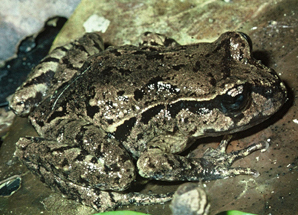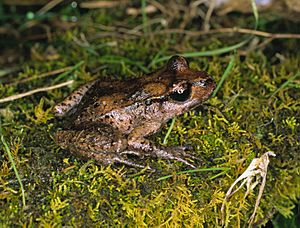Maud Island frog facts for kids
Quick facts for kids Maud Island frog |
|
|---|---|
 |
|
| Conservation status | |
| Scientific classification | |
| Genus: |
Leiopelma
|
| Species: |
pakeka
|
 |
|
| Range of Maud Island Frog | |
The Maud Island frog (Leiopelma pakeka) is a special kind of frog from New Zealand. It is one of only four types of native frogs left in the Leiopelma family. These frogs are considered "primitive," meaning they have kept some features from their ancient ancestors.
About the Maud Island Frog
The Maud Island frog is a small frog that lives on land. It can grow up to 5 centimeters long. It is usually medium to dark brown. Unlike some frogs, its toes are not webbed. It also has a special ridge behind its eyes. This frog is a bit bigger and slightly different in color from its close relative, the Hamilton's frog (Leiopelma hamiltoni).
Life Cycle of the Maud Island Frog
Just like other Leiopelma frogs, Maud Island frogs lay their eggs on damp ground. They usually lay between one and 19 eggs in December. The male frog then guards these eggs for about 14 to 21 weeks. When the eggs hatch, tiny froglets appear. The dad frog carries these froglets on his back until they are old enough to live on their own.
Scientists have been studying these frogs since 1983. They found that Maud Island frogs live a very long time! Some frogs have lived for 35 to 40 years, making them the longest-living wild frogs in the world. These frogs are very good at hiding and do not move much. They spend their whole lives in a small area, about 30 square meters. They only move the center of their home by about 1.3 meters every 10 years. This is one of the smallest "home ranges" known for any animal with a backbone!
How Scientists Named This Frog
The frogs living on Maud Island in Pelorus Sound, Marlborough, were first found in 1940. For a long time, people thought they were the same as the L. hamiltoni frogs found on nearby Stephens Island.
But in 1998, scientists looked closely at the proteins in the frogs' muscles. They found enough differences between the Maud Island frogs and the Stephens Island frogs to say they were a separate species. They named the Maud Island frog L. pakeka. "Pakeka" is a Māori word for Maud Island. This discovery meant that the total number of L. hamiltoni frogs in the world was much smaller than thought, with fewer than 300 living on Stephens Island.
More recent studies looking at the frogs' DNA have shown something different. The DNA differences between L. pakeka and L. hamiltoni are not much greater than the differences between groups of Archey's frog (L. archeyi). This makes some scientists wonder if the Maud Island frog should still be considered a separate species.
Protecting the Maud Island Frog
The Maud Island frog is listed as "nationally endangered" in New Zealand. This means it is at high risk of disappearing. At first, all these frogs lived in a small forest area of about 16 hectares on Maud Island. Even though there are many frogs on Maud Island (estimated 27,500 to 39,500), they are still in danger. Things like fungal diseases, natural disasters, climate change, or new animal predators could harm them. For example, mice got onto Maud Island in 2013, but they were removed, and the island was declared free of predators in November 2016.
To help protect the Maud Island frog, conservationists have started moving them to new islands. In 1984–85, 100 frogs were moved to a different part of Maud Island, which successfully created a new group. In 1997, 300 frogs were moved about 25 kilometers to Motuara Island in Queen Charlotte Sound. This was the first time New Zealand frogs had been moved between islands. This move was very successful because Motuara Island had better places for the frogs to live and was protected by a special fence that kept out kiwis and other animals. A later move of 100 frogs to nearby Long Island in 2006 was not as successful.
In 2006, 60 Maud Island frogs were released into the Karori Wildlife Sanctuary near Wellington. This sanctuary has special fences to keep out predators. Another 100 frogs were released there in 2012. Most of these frogs were put inside a special area protected from kiwis and mice. However, 29 frogs were placed outside this area for a study. In February 2008, 13 tiny froglets were found clinging to adult male frogs inside the protected area, showing they were reproducing. Most of the frogs placed outside the protected area disappeared.
See also
 In Spanish: Leiopelma pakeka para niños
In Spanish: Leiopelma pakeka para niños



